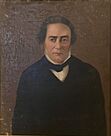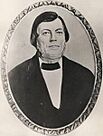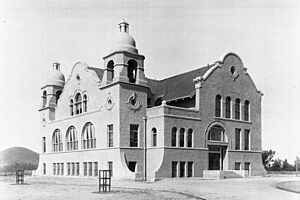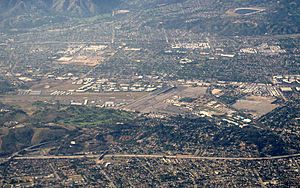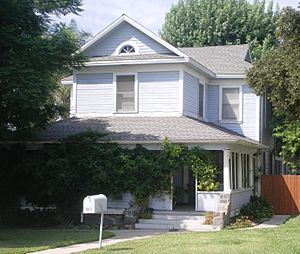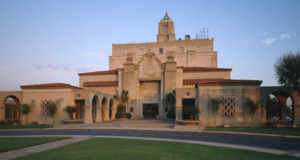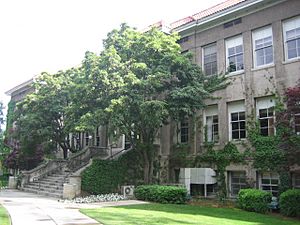La Verne, California facts for kids
Quick facts for kids
La Verne, California
|
||
|---|---|---|
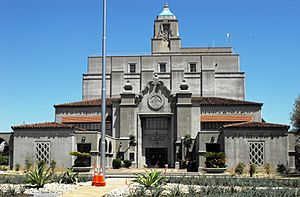
Weymouth Treatment Plant
|
||
|
||
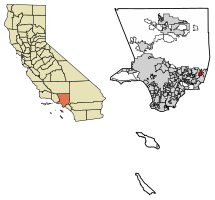
Location of La Verne in Los Angeles County, California.
|
||
| Country | United States | |
| State | California | |
| County | Los Angeles | |
| Incorporated | August 20, 1906 | |
| Government | ||
| • Type | Council-Manager government | |
| Area | ||
| • Total | 8.55 sq mi (22.16 km2) | |
| • Land | 8.43 sq mi (21.84 km2) | |
| • Water | 0.12 sq mi (0.31 km2) 1.54% | |
| Elevation | 1,060 ft (323 m) | |
| Population
(2020)
|
||
| • Total | 31,334 | |
| • Density | 3,791.53/sq mi (1,463.90/km2) | |
| Time zone | UTC-8 (PST) | |
| • Summer (DST) | UTC-7 (PDT) | |
| ZIP code |
91750
|
|
| Area code | 909 | |
| FIPS code | 06-40830 | |
| GNIS feature IDs | 1660868, 2411584 | |
La Verne is a city in Los Angeles County, California, United States. It is a friendly place with a rich history. In 2020, about 31,334 people lived there.
Contents
History of La Verne
The land where La Verne now stands was originally home to Native American people.
Early European Settlers
European history in the area began in the 1830s. Two men, Ygnacio Palomares and Ricardo Véjar, received a huge land grant in 1837. This grant, called Rancho San Jose, was about 15,000 acres. It included land that is now Pomona, Claremont, San Dimas, Glendora, and La Verne.
Ygnacio Palomares built a special house, an adobe, in 1837. This house, called La Casa Primera de Rancho San Jose, is still in Pomona today. He later built another adobe nearby. His nephew, Jose Dolores Palomares, also got land in the area.
From Lordsburg to La Verne
In the mid-1880s, a businessman named Isaac W. Lord bought some of Jose Palomares' land. He convinced the Santa Fe Railroad to build its tracks through his property, heading towards Los Angeles.
In 1887, Lord planned out building lots and held a big land sale. He named the new town 'Lordsburg' after himself. He also built a large hotel, the Lordsburg Hotel. However, the land boom ended before the hotel was finished. It stayed empty for several years.
Later, four members of the German Baptist Brethren Church bought the hotel. They believed it would be a great place for a new college. So, Lordsburg College was started in 1891. This college is now known as the University of La Verne.
In 1906, the town officially became a city and changed its name to "La Verne." People in the city first grew field crops. Then, they started planting citrus trees, like oranges, which grew very well. Lordsburg became famous as the "Heart of the Orange Empire." La Verne thrived as a center for the citrus industry until after World War II. After the war, the citrus industry slowly became less important. Today, you can still see two orange groves at the La Verne Heritage Foundation.
Geography and Climate
La Verne is a suburb located about 30 miles east of Los Angeles. It sits in the Pomona Valley, just below the San Gabriel Mountains. These mountains are part of the Angeles National Forest, where black bears live.
The city covers about 8.56 square miles. It is east of San Dimas and west of Claremont. The city of Pomona is to the south. California State Route 210 runs through La Verne from east to west. Historic U.S. Route 66 also passes through the city.
Weather in La Verne
La Verne has a warm-summer Mediterranean climate. This means it has warm, dry summers and mild, wet winters.
Population and People
| Historical population | |||
|---|---|---|---|
| Census | Pop. | %± | |
| 1910 | 954 | — | |
| 1920 | 1,698 | 78.0% | |
| 1930 | 2,860 | 68.4% | |
| 1940 | 3,092 | 8.1% | |
| 1950 | 4,198 | 35.8% | |
| 1960 | 6,516 | 55.2% | |
| 1970 | 12,965 | 99.0% | |
| 1980 | 23,508 | 81.3% | |
| 1990 | 30,897 | 31.4% | |
| 2000 | 31,638 | 2.4% | |
| 2010 | 31,063 | −1.8% | |
| 2020 | 31,334 | 0.9% | |
| U.S. Decennial Census 1860–1870 1880–1890 1900 1910 1920 1930 1940 1950 1960 1970 1980 1990 2000 2010 2020 |
|||
La Verne first appeared as a city in the 1910 U.S. Census. Since then, its population has grown quite a bit.
Who Lives in La Verne?
The city of La Verne is home to a diverse group of people. Here's a look at the different groups living there, based on the 2020 census:
| Race / Ethnicity (NH = Non-Hispanic) | Pop 2000 | Pop 2010 | Pop 2020 | % 2000 | % 2010 | % 2020 |
|---|---|---|---|---|---|---|
| White alone (NH) | 20,129 | 17,197 | 14,373 | 63.62% | 55.36% | 45.87% |
| Black or African American alone (NH) | 975 | 992 | 906 | 3.08% | 3.19% | 2.89% |
| Native American or Alaska Native alone (NH) | 110 | 98 | 81 | 0.35% | 0.32% | 0.26% |
| Asian alone (NH) | 2,244 | 2,310 | 3,379 | 7.09% | 7.44% | 10.78% |
| Native Hawaiian or Pacific Islander alone (NH) | 41 | 54 | 47 | 0.13% | 0.17% | 0.15% |
| Other race alone (NH) | 44 | 58 | 183 | 0.14% | 0.19% | 0.58% |
| Mixed race or Multiracial (NH) | 780 | 719 | 1,180 | 2.47% | 2.31% | 3.77% |
| Hispanic or Latino (any race) | 7,315 | 9,635 | 11,185 | 23.12% | 31.02% | 35.70% |
| Total | 31,638 | 31,063 | 31,334 | 100.00% | 100.00% | 100.00% |
In 2020, about 55.3% of the people in La Verne were White. About 3.1% were African American, and 11.2% were Asian. Many people also identified as Hispanic or Latino, making up about 35.7% of the population.
Most people in La Verne live in family homes. In 2020, the average household had about 2.63 people. The median age was about 45.9 years old. This means half the people were younger than 45.9, and half were older.
In 2023, the average income for a household in La Verne was about $104,565.
City Government
La Verne is part of the 5th district of Los Angeles County. It is overseen by a supervisor named Kathryn Barger.
For the state government, La Verne is in the 22nd Senate District. This district is represented by Susan Rubio. It is also in the 41st Assembly District.
In the United States Congress, La Verne is in the 31st District. This district is represented by Gil Cisneros. California's U.S. Senators are Alex Padilla and Adam B. Schiff.
The city has its own police and fire departments to keep everyone safe. The La Verne Police Department provides law enforcement. In 2018, Colleen Flores became the first woman captain in the department. Samuel Gonzalez is the current chief of police. The La Verne Fire Department handles fire protection and medical emergencies.
Education in La Verne
La Verne is home to the University of La Verne, a college located on 3rd Street.
The Bonita Unified School District serves the city's younger students. Bonita High School is one of the main high schools. Other schools in the area include Damien High School, a Catholic school for boys, and Calvary Baptist Schools. Lutheran High School, which was on Fruit Street, closed in 2024.
Transportation
Getting around La Verne and to nearby cities is becoming easier. The Los Angeles Metro Rail A Line is being extended. This train line now reaches Pomona. The La Verne/Fairplex station, located near the University of La Verne, started service in early 2025.
Notable People from La Verne
Many interesting people have connections to La Verne, including:
- Ewell Blackwell - A professional baseball pitcher.
- Noah Clarke - A professional hockey player.
- Glenn Davis - A famous American football player and Heisman Trophy winner.
- Ryan Stonehouse - An American football player.
- Jason David Frank - An MMA fighter.
- Jeffrey Garcia - A comedian, voice actor, and radio DJ.
- Erin Gruwell - The author of The Freedom Writers Diary.
- Sugar Shane Mosley - A professional boxer.
- Paula Jean Myers-Pope - An Olympic diver who won four medals.
See also
 In Spanish: La Verne para niños
In Spanish: La Verne para niños




